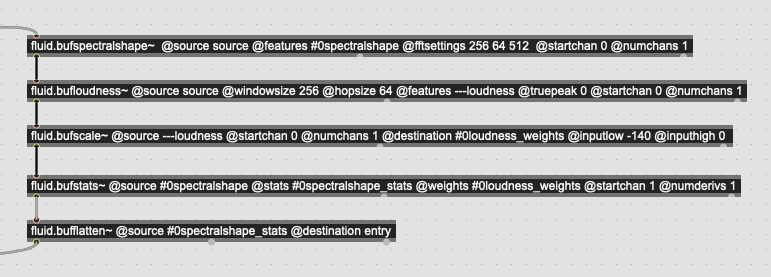I could have sworn I posted about this before, but did a fairly thorough search, and other than a mention in passing in other threads, there’s not a solid thread/request for it.
I’ve presently been squinting at my screen for like 20min, jumping between help files, frantically printing fluid.dataset~s to the Max window, all to try and figure out descriptors/stats are presently in my flattened buffer.
I have this analysis chain here:
which is producing a 98d space of 7 spectral descriptors, along with 7 statistics and one derivative.
I want to be able to produce a coll that has labels for what’s in each point in the vector, so I can test some SVM/PCA shenanigans on it, but for the life is it harder than it seems. I feel like I’m re-reading the same sentence over and over in a book and getting nowhere with it. I can fluid.buf2list the @stats buffer and kind of make sense from that, but once it’s flattened it turns into a multidimensional “indices math” problem. (I’ve not even started doing the 20MFCC or 40melband equiv of this proces…).
Given that buffers are 1d, there sadly isn’t a way to attach symbolic information to each step of the process at source, so it would be great to have something like fluid.labelset~ but that wasn’t so narrow in it’s usability (e.g. a “black box”(i.e. it would be great to create a “label set” that contained information about what was in a “data set” (both in terms of rows as well as columns (my main point of confusion here))).
So it’s kind of a two part request here. One is having some kind of native way to do this (like adding “labels” to “data”), and the other one is being able to programmatically generate this information in the first place. As in, having some kind of trace and/or legible pattern through the descriptors->stats->flatten pipeline such that you know what is where without having to pull out a piece of paper and draw a diagram.
This would also be incredibly handy if it ever becomes possible to pick/choose what descriptors/statistics you want in the first place as you would presumably need some way to specify what data you want in the first place, or at minimum, an easier way to select what data gets carried on in the process (that hopefully/mercifully doesn’t involve counting unlabelled indices…(presently lower than buffer~s-as-containers in my list of least favorite things)).
